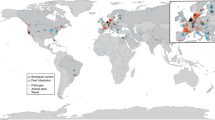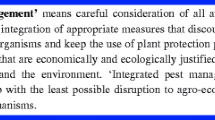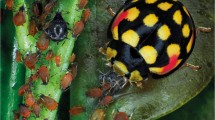Abstract
Plant protection is one of the major issues in organic farming. Organic crop protection (OCP) strategies often rely on a limited number of methods that provide only partial control of pests and that induce lower yields and economic performances. As a result, farmers hesitate to adopt these strategies and doubts are cast on the ability of organic agriculture to feed the world. This chapter questions how agroecological concepts may contribute to OCP, while taking the different alternative schemes already developed to manage, integrate and design crop protection strategies into account. As demonstrated by a bibliographic analysis, Integrated pest management (IPM) remains the leading paradigm in crop protection. It also provides its foundational basis, giving priority to bioecological processes and alternative techniques to reduce pesticide use. Beyond IPM, agroecology is characterised by a holistic approach and the importance given to the design of a “healthy” agroecosystem. In practice, all these concepts are subject to various interpretations, and organic farming includes a variety of practices, ranging from intensive input-substitution to a comprehensive integrated approach. This paper provides key elements for crop protection in OF on the basis of the adaptation of the agroecological crop protection approach. Based on a successful case study of fruit fly management in OF in Reunion Island (France), we highlight three major pillars to design pest management strategies: sanitation, habitat manipulation and conservation biological control. Finally, in the field of crop protection, this paper shows that organic farming can be both a prototype for designing innovations and a source of practices to be extended to other types of agroecosystems.
Access this chapter
Tax calculation will be finalised at checkout
Purchases are for personal use only
Similar content being viewed by others
References
Altieri MA (1992) Sustainable agricultural-development in latin-america—exploring the possibilities. Agric Ecosyst Environ 39(1–2):1–21
Altieri MA, Nicholls CI (2000) Applying agroecological concepts to development of ecologically based pest management strategies. National Research Council, Washington DC
Altieri MA, Rosset P (1999) Ten reasons why biotechnology will not ensure food security, protect the environment and reduce poverty in the developing world. In: Sherlock R, Moorey JD (eds) Ethical issues in biotechnology. Rowman & Littlefield
Altieri MA (2005) The myth of coexistence: why transgenic crops are not compatible with agroecologically based systems of production. B Sci Technol Soc 25(4):361
Atiama-Nurbel T, Deguine JP (2010) Agroecological crop protection in organic agriculture: the case of Tephritid fruit flies in Reunion Island, international conference on organic agriculture in scope of environmental problems. Famagusta, Cyprus, pp 107–109
Augusseau X, Deguine JP, Douraguia E, Duffourc V, Gourlay J, Insa G, Lasne A, Le Roux K, Poulabssia E, Rousse P, Roux E, Suzanne W, Tilma P, Trules E (2011) Gamour, l’agroécologie en action à la Réunion. Phytoma, pp 33–37
Biondi A, Desneux N, Siscaro G, Zappala L (2012) Using organic-certified rather than synthetic pesticides may not be safer for biological control agents: Selectivity and side effects of 14 pesticides on the predator Orius laevigatus. Chemosphere 87(7):803–812
Bird GW, Grieshop M, Hepperly P, Moyer J (2009) Climbing Mt. organic: an ecological approach. In: Francis C (ed) Organic farming: the ecological system. American society of agronomy, crop science society of America, Soil science society of america, pp 197–214
Boisclair J, Estevez B (2006) Insect pest management in organic agriculture: acting in harmony with complexity. Phytoprotection 87(2):83–90
Daniel C, Pfammatter W, Kehrli P, WYSS E (2005) Processed kaolin as an alternative insecticide against the European pear sucker, Cacopsylla pyri (L.). J Appl Entomol 129(7):363–367
Darnhofer I, Lindenthal T, Bartel-Kratochvil R, Zollitsch W (2010) Conventionalisation of organic farming practices: from structural criteria towards an assessment based on organic principles. A review. Agron Sustain Dev 30:67–81. DOI: http://dx.doi.org/10.1051/agro/2009011
Dayan FE, Cantrell CL, Duke SO (2009) Natural products in crop protection. Bioorg Med Chem 17:4022–4034. DOI: 10.1016/j.bmc.2009.01.046
Deguine JP, Ferron P (2006) Crop protection, preservation of biodiversity, respect of the environment. Cah Agric 15(3):307–311
Deguine JP, Ferron P, Russell D (2008) Sustainable pest management for cotton production. A review. Agron Sustain Dev 28(1):113–137
Deguine JP, Ferron P, Russell D (eds) (2009) Crop protection: from agrochemistry to agroecology. Science, Enfield, p 378.
Deguine JP, Atiama-Nurbel T, Quilici S (2011) Net choice is key to the augmentorium technique of fruit fly sequestration and parasitoid release. Crop Prot 30:198–202. DOI: 10.1016/j.cropro.2010.10.007
Deguine J-P, Atiama-Nurbel T, Douraguia E, Chiroleu F, Quilici S (2012a) Species diversity within a community of the Cucurbit fruit flies Bactrocera cucurbitae, Dacus ciliatus and Dacus demmerezi roosting in corn borders near cucurbit production areas of Reunion Island. J Insect Sci 12(32). insectscience.org/12.32
Deguine J-P, Douraguia E., Atiama-Nurbel T., Chiroleu F., Quilici S (2012b) Cage study of spinosad-based bait efficacy on Bactrocera cucurbitae, Dacus ciliatus and Dacus demmerezi in Reunion Island. J Econ Entomol 105:1358–1365
Deguine J-P, Rousse P, Le Roux K, Augusseau X (2011) Agroecological crop protection in Reunion: first results in commercial farm conditions. Commun Agric Appl Biol Sci 76:107–118
Delate K (2002) Using an agroecological approach to farming systems research. Horttechnology 12(3):345–354
Delate K, Friedrich H (2004) Organic apple and grape performance in the Midwestern US. In: Bertschinger L, Anderson JD (coord.) (eds) Sustainability of horticultural systems in the 21st century. Leuven 1: International Society Horticultural Science, pp 309–320
Drinkwater LE (2009) Ecological knowledge:foundation for sustainable organic agriculture. In: Francis C (ed) Organic farming: the ecological system. American society of agronomy, crop science society of America, soil science society of America, pp 19–47
Ehler LE (2006) Integrated pest management (IPM) definition, historical development and implementation, and the other IPM. Pest Manag Sci 62:787–789. DOI: 10.1002/ps.1247
Elliot SL, Mumford JD (2002) Organic, integrated and conventional apple production: why not consider the middle ground? Crop Prot 21(5):427–429.
FAO/WHO Codex Alimentarius Commission (1999) Organic agriculture. Committee on Agriculture, Rome
Fernandes VC, Domingues VF, De Freitas V, Delerue-Matos C, Mateus N (2012) Strawberries from integrated pest management and organic farming: phenolic composition and antioxidant properties. Food Chem 134(4):1926–1931
Ferron P, Deguine JP (2005) Crop protection, biological control, habitat management and integrated farming. A review. Agron Sustain Dev 25:17–24. DOI: 10.1051/agro:2004050
Francis C (2009a) Education in organic farming and food systems. In: Francis C (ed) Organic farming: the ecological system, American society of agronomy, crop science society of America. Soil Science Society of America, pp 283–299
Francis C (Eds) (2009b) Organic farming: the ecological system. American Society of Agronomy, Inc, Madison
Furlong MJ, Zalucki MP (2010) Exploiting predators for pest management: the need for sound ecological assessment. Entomol Exp Appl 135(3):225–236.
Garratt MPD, Wright DJ, Leather SR (2011) The effects of farming system and fertilisers on pests and natural enemies: A synthesis of current research. Agricu Ecosyst Environ 141(3–4):261–270
Gliessman SR (Eds) (2007) Agroecology: the ecology of sustainable food systems, CRC Press, pp 384
Guthman J (2004) The trouble with ‘organic lite’ in California: A rejoinder to the ‘conventionalisation’ debate. Sociol Ruralis 44:301–316
Harper JL (1974) Agricultural ecosystems. Agro-Ecosyst 1:1–6. DOI: 10.1016/0304–3746(74)90002-x
Hill SB, Vincent C, Chouinard G (1999) Evolving ecosystems approaches to fruit insect pest management. Agric Ecosyst Environ 73:107–110
Hill SB (2014) Considerations for enabling the ecological redesign of organic and conventional agriculture: a sociology and psychosocial perspective. In: Bellon S, Penvern S (eds) Organic agriculture, prototype for systainable agricultures. Springer, Chap. 22, pp 401–422
Holland JM, Birkett T, Southway S (2009) Contrasting the farm-scale spatio-temporal dynamics of boundary and field overwintering predatory beetles in arable crops. BioControl 54(1):19–33
Howard A (1943) An agricultural testament. Oxford University Press, p 228
Jacobson SK, Sieving KE, Jones GA, Van Doorn A (2003) Assessment of farmer attitudes and behavioral intentions toward bird conservation on organic and conventional Florida farms. Conserv Biolo 17(2):595–606
Kogan M (1998) Integrated pest management: historical perspectives and contemporary developments. Ann Rev Entomol 43:243–270. DOI: doi:10.1146/annurev.ento.43.1.243
Kogan M, Hilton RJ (2009) Conceptual framework for integrated pest management (IPM) of tree-fruit pests. In: Aluja M et al (eds) Biorational tree-fruit pest management. CABI, pp 1–31
Krebs JR, Wilson JD, Bradbury RB, Siriwardena GM (1999) The second silent spring? Nature 400:611–612
Kremen C, Miles A (2012) Ecosystem services in biologically diversified versus conventional farming systems: benefits, externalities, and trade-offs. Ecol Soc 17(4):40
Lamine C (2011) Transition pathways towards a robust ecologization of agriculture and the need for system redesign. Cases from organic farming and IPM. J Rural Stud 27:209–219. DOI: 10.1016/j.jrurstud.2011.02.001
Lampkin N (1990) Organic farming. Farming Press, Ipswich
Letourneau DK, Goldstein B (2001) Pest damage and arthropod community structure in organic vs. conventional tomato production in California. J Appl Ecol 38:557–570. DOI: 10.1046/j.1365–2664.2001.00611.x
Lewis WJ, vanLenteren JC, Phatak SC, Tumlinson JH (1997) A total system approach to sustainable pest management. Proceedings of the national academy of sciences of the United States of America 94:12243–12248
Lotter DW (2003) Organic agriculture. J Sustain Agricu 21:59–128
Malezieux E (2012) Designing cropping systems from nature. Agron Sustain Dev 32(1):15–29
Mayes MA, Thompson G.D., Husband B, Miles MM (2003) Spinosad toxicity to pollinators and associated risk, reviews of environmental contamination and toxicology, vol 179. Springer, New York, pp 37–71
McQuate GT, Vargas RI (2007) Assessment of attractiveness of plants as roosting sites for the melon fly, Bactrocera cucurbitae, and oriental fruit fly, Bactrocera dorsalis. J Insect Sci 7:57
Mcsorley R (2002) Nematode and insect management in transitional agricultural systems. Horttechnology 12(4):597–600
Mena Y, Nahed J, Ruiz FA, Sanchez-Munoz JB, Ruiz-Rojas JL, Castel JM (2012) Evaluating mountain goat dairy systems for conversion to the organic model, using a multicriteria method. Animal 6(4):693–703.
Mumford J D (1992) Economics of integrated pest-control in protected crops. Pestic Sci 36(4):379–383
Mladenova R, Shtereva D (2009) Pesticide residues in apples grown under a conventional and integrated pest management system. Food Additives and Contaminants Part A-Chemistry Analysis Control Exposure & Risk Assessment 26(6):854–858
Mzoughi N (2011) Farmers adoption of integrated crop protection and organic farming: Do moral and social concerns matter? Ecol Econ 70(8):1536–1545
Nicholls CI, Altieri MA (1997) Conventional agricultural development models and the persistence of the pesticide treadmill in Latin America. Int J Sustain Dev World Ecol 4(2):93–111
Peck GM, Merwin IA, Brown MG, Agnello AM (2010) Integrated and organic fruit production systems for ‘liberty’ apple in the northeast United States: a systems-based evaluation. Hortscience 45(7):1038–1048
Penvern S, Bellon S, Fauriel J, Sauphanor B (2010) Peach orchard protection strategies and aphid communities: Towards an integrated agroecosystem approach. Crop Prot 29:1148–1156. DOI: 10.1016/j.cropro.2010.06.010
Peterson G, Cunningham S, Deutsch L, Erickson J, Quinlan A, Raez-Luna E, Tinch R, Troell M, Woodbury P, Zens S (2000) The risks and benefits of genetically modified crops: A multidisciplinary perspective. Conserv Ecol 4(1):13
Ponce NLC (2007) Evaluation of knowledge agroecologiques in organic and conventional horticulturists of the north zone of Cartago, Costa Rica. Cuadernos De Desarrollo Rural 3(58):37–48
Rajapakse R, BCPC (2000) The management of major insect pests Bactocera cucurbitaceae and Aulacaphora spp. in cucurbits under 3 intensive systems: Integrated chemical and organic agriculture in Southern Sri Lanka. Bcpc Conference: Pests & Diseases 2000, vols 1–3, Proceedings. British Crop Protection Council, Farnham, p 981–985
Ratnadass A, Fernandes P, Avelino J, Habib R (2012) Plant species diversity for sustainable management of crop pests and diseases in agroecosystems: a review. Agron Sustain Dev 32(1):273–303
Rodriguez E, Gonzalez B, Campos M (2012) Natural enemies associated with cereal cover crops in olive groves. Bulletin of Insectology 65(1):43–49
Rosset PM, Altieri MA (1997) Agroecology versus input substitution: a fundamental contradiction of sustainable agriculture. Soc Nat Resour 10:283–295
Ryckewaert P, Deguine JP, Brevault T, Vayssieres JF (2010) Fruit flies (Diptera: Tephritidae) on vegetable crops in Reunion Island (Indian Ocean): state of knowledge, control methods and prospects for management. Fruits 65:113–130. DOI: 10.1051/fruits/20010006
Sauphanor B, Simon S, Boisneau C, Capowiez Y, Rieux R, Bouvier JC, Defrance H, Picard C, Toubon JF (2009) Protection phytosanitaire et biodiversité en agriculture biologique. Le cas des vergers de pommiers. Innovations Agronomiques 4:217–228
Sharma OP, Bhosle BB, Kamble KR, Bhede BV, Seeras NR (2011) Management of pigeonpea pod borers with special reference to pod fly (Melanagromyza obtusa). Indian J Agric Sci 81(6):539–543
Simon S, Rusch A, Wyss E, Sarthou JP (2014) Organic farming as an inspirational model for developing conservation biocontrol. In: Bellon S, Penvern S (eds) Organic farming, prototype for sustainable agricultures. Springer, Chap. 5, pp 83–105
Speiser B, Tamm L and Weibel FP (2014) Regulatory framework for plant protection in organic farming. In: Bellon S, Penvern S (eds) “Organic agriculture, prototype for sustainable agricultures”, Chap. 4, pp 65–82
Tscharntke T, Clough Y, Wanger TC, Jackson L, Motzke I, Perfecto I, Vandermeer J, Whitebread A (2012) Global food security, biodiversity conservation and the future of agricultural intensification. Biol Cons 151(1):53–59
Trewavas A (2001) Urban myths of organic farming. Nature 410:409–410
Valenzuela HR, Defrank J (1995) Agroecology of tropical underground crops for small-scale agriculture. Cr Rev Plant Sci 14(3):213–238
Vanbuskirk P.D., Hilton R.J., Benbow J., Basile S (2008) Mating disruption and Cydia pomonella Granulosis virus for control of codling moth in pear. In: Webster AD, Oliveira CM (coord.) (eds) Proceedings of the Xth international pear symposium, vols 1–2. Leuven 1: International Society Horticultural Science, p 947–953
Vandermeer J (1995) The ecological basis of alternative agriculture. Ann Rev Ecol Syst 26:201–224
Vanloqueren G, Baret PV (2009) How agricultural research systems shape a technological regime that develops genetic engineering but locks out agroecological innovations. Res Policy 38:971–983. DOI: 10.1016/j.respol.2009.02.008
Veyssières JF (1999) Les relations plantes-insectes chez les Dacini (Diptera-Tephritidae) ravageurs des Cucurbitaceae à La Réunion. University Paris XII, Paris
Wezel A, Bellon S, Dore T, Francis C, Vallod D, David C (2009) Agroecology as a science, a movement and a practice. A review. Agron Sustain Dev 29:503–515. DOI: 10.1051/agro/2009004
White IM, Elson-Harris MM (1992) Fruit flies of economic significance: their identification and bionomic. CAB International, Wallingford
Whittaker J, Courtial JP, Law J (1989) Creativity and conformity in science—titles, keywords and co-word analysis. Soc Stud Sci 19:473–496
Wyss E, Luka H, Pfiffner L, Schlatter C, Gabriela U, Daniel C (2005) Approaches to pest management in organic agriculture: a case study in European apple orchards “IPM in Organic Systems”, XXII International Congress of Entomology, Brisbane, Australia
Xu QC, Fujiyama S, Xu HL (2011) Biological pest control by enhancing populations of natural enemies in organic farming systems. J Food Agric Environ 9(2):455–463
Zehnder G, Gurr GM, Kuhne S, Wade MR, Wratten SD, Wyss E (2007) Arthropod pest management in organic crops. Ann Rev Entomol 52:57–80
Zinati GM (2002) Transition from conventional to organic farming systems: I. Challenges, recommendations, and guidelines for pest management. Horttechnology 12(4):606–610
Acknowledgments
We would like to thank all of the readers who helped us to improve the quality of this paper and who contributed to the definition of each of the concepts herein. We are also grateful to Guillaume Ollivier for sharing his knowledge about bibliometry with us and his invaluable help in these discussions.
The case study relies on a vast effort provided by many people who unfortunately cannot all be mentioned here, although we acknowledge each and every one of them. We particularly thank Marie-Ludders Moutoussamy, Cédric Ajaguin Soleyen, Toulassi Atiama-Nurbel and Pascal Rousse for technical assistance in conducting experiments. We also acknowledge Dow AgroSciences (France) for permission to conduct trials on Synéïs-appât. Gamour was operated by a fruitful collaboration between ASP, DAAF, the Chamber of Agriculture of Reunion Island, CIRAD, Farre Reunion, FDGDON, GAB, Université de La Réunion, Takamaka Industries, SCA Terres Bourbon and Vivéa Réunion. Funding for this research was provided by Odeadom (Office de Développement de l’Economie Agricole des Départements d’Outre-mer), the European Commission, the Regional Council of Reunion Island, the General Council of Reunion Island, CIRAD and the French Ministry of Food, Agriculture and Fishing through a CAS-DAR grant.
Author information
Authors and Affiliations
Corresponding author
Editor information
Editors and Affiliations
Rights and permissions
Copyright information
© 2014 Springer Science+Business Media Dordrecht
About this chapter
Cite this chapter
Deguine, JP., Penvern, S. (2014). Agroecological Crop Protection in Organic Farming: Relevance and Limits. In: Bellon, S., Penvern, S. (eds) Organic Farming, Prototype for Sustainable Agricultures. Springer, Dordrecht. https://doi.org/10.1007/978-94-007-7927-3_6
Download citation
DOI: https://doi.org/10.1007/978-94-007-7927-3_6
Published:
Publisher Name: Springer, Dordrecht
Print ISBN: 978-94-007-7926-6
Online ISBN: 978-94-007-7927-3
eBook Packages: Biomedical and Life SciencesBiomedical and Life Sciences (R0)




